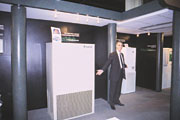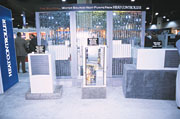These are often installed in schools and telecommunications rooms. Both applications make them ideal candidates for vandalproofing. Schools also benefit from sound-reduction features.

Vertical Units
TheMarvair(Cordele, GA) Scholar II 2- to 5-ton heat pump is designed to provide “comfortable, quiet, efficient packaged heating and cooling for school classrooms,” the company says.The unit is installed inside the classroom, against an exterior wall. A vandal-resistant outdoor box goes through the wall. The design makes the unit suitable for new construction and retrofit applications, the company says.
Models can be controlled by an internal thermostat, standard room thermostat, or interfaced with an energy management system. The unit’s operation falls within school decibel requirements.
In addition, ventilation rates meet ASHRAE 62-1999 standards. Features include manual or motorized damper operation with pressure relief; an optional GreenWheel™ energy recovery wheel that can recover sensible and latent heat with efficiencies up to 75%; and an optional power vent with motorized dampers. An economizer is also optional.
The company’s Classic heat pump is said to exceed current energy requirements under the National Energy Appliance Conservation Act (NAECA) in a variety of styles and configurations to meet various ventilation and cooling requirements. Units have a high-efficiency scroll compressor, lanced fins and rifled tubing, and two-speed indoor blower motor.
For school classrooms, models are available to comply with ASHRAE 62-1999. Where cooling is required during cooler weather (like telecommunications shelters), the Classic II is available with a factory-installed economizer.
For installation, the unit’s sloped top with flashing helps eliminate the need for a rain hood, the company says. Built-in, full-length mounting flanges aid installation and minimize the chance of leaks. And supply and return openings match previous models, the company said, making retrofits easier.
Options include a hard-start kit for use on single-phase equipment; this gives the compressor a higher starting torque under low-voltage conditions, the company says. An adjustable outdoor thermostat does not allow electric resistance heat to be energized unless the outdoor temperature is below the desired setpoint. And an “S” circuit limits electric demand by preventing simultaneous operation of the compressor and electric strip heat, the company says.
Friedrich (San Antonio, TX) displayed an outside, wall-mount air conditioner and heat pump. The relocatable unit is suitable for classrooms and telecommunications rooms.
Modular in construction, the unit’s capacity ranges from 24,000 to 60,000 Btuh. It features an industry-standard footprint and air openings, and can replace other manufacturers’ units “if the holes are already cut,” said company representative Ron Koehler.
The wall-mount model features the Copeland Scroll® compressor. OE/OH Series options include a fresh-air damper and economizer; expansion valves are standard.

The Bard (Bryan, OH) QTec Series heat pump is designed for “whisper quiet” operation, the company says. A soft start-stop ECM variable-speed motor is combined with sound-absorbing insulation to achieve this.
The unit offers a variety of ventilation options, including an integrated energy recovery ventilator. Supply air can be introduced through either a ceiling plenum or a ducted system. A dehumidification circuit can be specified for use with a humidistat option.
The unit features a Copeland Scroll® compressor and compressor time-delay relay; stainless steel drain pans; and a totally enclosed condenser motor with plug-in connector.
The unit’s circuit breaker/pull disconnect access door locks to safeguard against unauthorized entry. The unit also has tamper-resistant fasteners. A hinged, locked door gives service techs access to air filters and primary electrical controls. Techs will also appreciate a diagnostic service light in the control panel, which indicates high- or low-pressure control operation.

Geothermal Systems
Heat Controller(Jackson, MI) displayed its high-efficiency residential ground water and geothermal model heat pumps.An open-loop model is designed for ground water applications with water temperatures ranging from 45° to 70°F. These systems use stable ground water; the company says minimum excavation is required, minimizing a contractor’s installation costs. Closed-loop units are designed for applications with entering fluid temperatures from 30° to 100°. They use heat exchangers that have been designed “for practically any installation and can be installed in many different configurations,” the company says. These include vertical, horizontal, pond, or lake loops.
Vertical-configuration units can be applied in closet installations and provide “easy replacement of fossil fuel appliances.”
The horizontal model is compact, in capacities from 18,000 to 72,000 Btuh. It is said to be suitable for installation in confined spaces, such as drop ceilings, crawl spaces, and attic installations.
On the commercial side, the company’s water-to-air heat pumps can be applied to buildings ranging from offices, schools, health care, and retirement facilities, to hotels and motels, multifamily housing, and industrial applications.
HWY/VWY models are normally used with a closed-loop system that uses a cooling tower and boiler with entering water temperature between 55° and 95°. HGY/VGY models are rated for ground-loop heat exchanger application with an entering fluid temperature of 30° to 100°.
The vertical configuration of VWY models make them suitable for concealed and equipment closet applications. Each unit contains a compressor, reversing valve, metering device, and water-to-refrigeration heat exchanger.
Addison (also Heat Controller, Orlando, FL) displayed the X Streamline roof-mounted, downflow heat pump for ground water applications from 3 to 35 tons.
The unit’s single-wall, copper inner water tube heat exchanger is encapsulated in Isofroth polyurethane foam, also standard. One-in., foil-faced fiber glass insulation; 2-in. extended-surface pleated filters; and a motorized proportional outside air damper with termination for a 24-V circuit are optional.

Sidebar: Unitary on Display
ATLANTA, GA — While there weren’t as many unitary heat pumps on display as in years past, that’s not to say that there weren’t any.Nordyne (O’Fallon, MO) displayed unitary heat pump models from Frigidaire and Tappan.
Frigidaire and Tappan FS3B and FT3B Series 10-, 12-, and 13-SEER heat pumps feature a removable top grille to allow service from the top without disconnecting the fan motor leads; the full-service brass valves are accessible, simplifying service, the company says.
The units also feature copper tubing and aluminum fin coils and a permanently lubricated motor. Units are ideal for slab or rooftop mounting in single, multifamily, and light commercial applications.
Eubank (Longview, TX) showed its C12 high-efficiency residential and light commercial 12-SEER condensing units featuring quiet top air discharge; an exterior cabinet coated with a 1,000-hr salt spray polyester finish; copper tube, coated aluminum fin refrigerant coils; a “state-of-the-art” reciprocating and scroll compressor; polyester-coated fan and condenser coil guards; a fan guard mount; a larger wrap-around coil surface; and a control box located for easy access to electrical controls.
All models use R-22 and have a permanent-split capacitor (psc) motor.
And Mitsubishi Climate Control (Rancho Dominguez, CA) showed multizone heat pumps in natural gas engine-driven and inverter-controlled electric condensing units. Both models should be available for sale in mid-year.
The gas engine unit will be offered in 16- and 20-ton capacities; the electric model will be available in 8- and 10-ton capacities. The electric unit features two inverter-driven scroll compressors, digitally controlled electronic expansion valves, microcomputer control, and self-diagnosis. The company calls it “an excellent replacement for chiller systems, vav units, and for new construction.”
Publication date: 02/19/2001

Report Abusive Comment